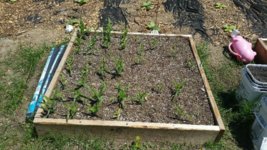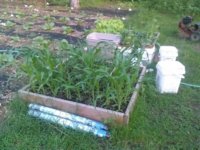Garlic size varies within any specific variety, but some varieties tend to produce very large heads. Although you can simply buy a head of garlic at the supermarket, and plant the cloves to get some very nice garlic, I often purchase a couple of heads of specific varietals from Seed Savers (
http://www.seedsavers.org/onlinestore/Garlic/). Seed Savers won't begin to ship until September.
Broadleaf Czech Garlic, hanging near the exhaust fan in my tobacco shed.
Even within a specific variety, the head size varies a lot.
I prepare the bed in the fall, and plant the cloves (~8" apart in all directions) at the end of October. They seem to benefit from heavy mulching, so I cover the bed with about 8" of pine needles, and just leave it undisturbed all winter. They are usually ready for digging-up in the first week of June. Consumers are accustomed to garlic appearing nice and clean, but they dry most successfully if the dirt is just roughly removed, and the garlic hung to dry as is. Washing them after digging often causes mold problems.
After allowing the freshly-dug garlic to wilt and dry a few hours in the sun, I hang it in my tobacco shed, near the exhaust fan. By grasping 3 or 4 garlics in each hand, I just tie the leaves in a square knot, and dangle them over one of the suspension ropes of the shed. I have never noticed any garlic aroma in the tobacco. Of course, the garlic has dried by the time any tobacco begins to appear in the shed, and the garlic is removed to the kitchen before long (as soon as the leaves have lost most of their moisture, and can be easily braided).
When they have dried a few weeks, and I'm ready to braid them into a rope (mostly for the fun of having a rope of garlic hanging in the kitchen), I carefully peel off the outer layer, which removes the dirt. The soft-neck varieties can be braided. The hard-neck varieties cannot, because of the stick-like scape.
Because the skin around each individual clove is still succulent, freshly dug garlic is difficult to peel, but incredibly tangy. As they hang in the kitchen through the dry indoor humidity of winter, they become much easier to peel, and the spiciness tames down.
Bob












